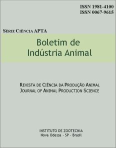Effects of levels of sulphur as gypsum for the growth of forage legumes in the State of So Paulo, Brazil
Abstract
A pot experiment was carried out n a greenhouse in the Instituto de Zootecnia at Nova Odessa, State of Sãp Paulo. Four forage legumes (siratro, galactia, perennial soybean and centro) were grown in Psamments soil from Brotas (cerrado region) and in a Red-Yellow Podzolic soil Laras variation from Nova Odessa. These species grew since November until January (Spring-Summer). Five levels of sulphur (0;30;60;90 and l20kg/ha) as gypsum were applied. The best responses to sulphur were obtained with siratro grown in the Psamments sou. Maximum values for dry matter production, nitrogen content and dry weight of nodules in siratro were obtained with applications of 76 to 86kg S1ha. Galactia grown in the soil from Brotas increased its nodulation with the level of 60kg S/ha. The mineralization of the organic matter during the experimental period would have released mineral sulphur to the soil and would have prevented other responses to the levels of sulphur, specially in the Podzolic soil. Gypsum resulted in a reduction of soil pH in the pots that received lime to neutralize exchangeable aluminum and increased soil exchangeable calcium irrespective to the limestone level. Centro and galactia grown in the soil from Brotas showed deformed leaflets. These symptoms were not related to the treatments studied but they were similar to those obtained with the application of 2.4-D herbicide on the plant tops.Downloads
Downloads
Published
Issue
Section
License
Os autores não serão remunerados pela publicação de trabalhos, pois devem abrir mão de seus direitos autorais em favor deste periódico. Por outro lado, os autores ficam autorizados a publicar seus artigos, simultaneamente, em repositórios da instituição de sua origem, desde que citada a fonte da publicação original seja Boletim de Indústria Animal. A revista se reserva o direito de efetuar, nos originais, alterações de ordem normativa, ortográfica e gramatical, com vistas a manter o padrão culto da língua e a credibilidade do veículo. Respeitará, no entanto, o estilo de escrever dos autores. Alterações, correções ou sugestões de ordem conceitual serão encaminhadas aos autores, quando necessário. Nesses casos, os artigos, depois de adequados, deverão ser submetidos a nova apreciação. As opiniões emitidas pelos autores dos artigos são de sua exclusiva responsabilidade. Todo o conteúdo deste periódico, exceto onde está identificado, está licenciado sob a Licença Creative Commons Attribution (CC-BY-NC). A condição BY implica que os licenciados podem copiar, distribuir, exibir e executar a obra e fazer trabalhos derivados com base em que só se dão o autor ou licenciante os créditos na forma especificada por estes. A cláusula NC significa que os licenciados podem copiar, distribuir, exibir e executar a obra e fazer trabalhos derivados com base apenas para fins não comerciais.













